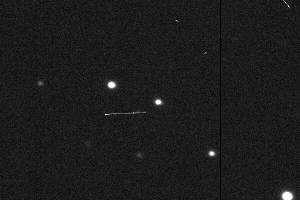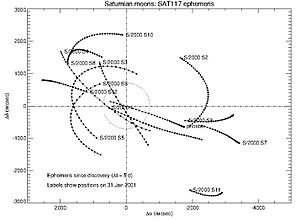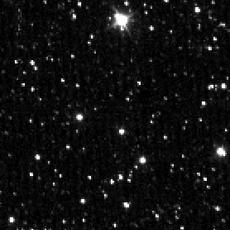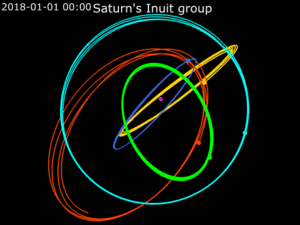Siarnaq facts for kids
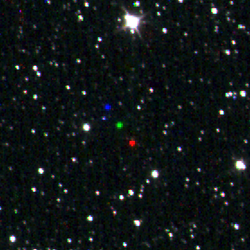
Composite of three images taken by the Cassini spacecraft in 2013, showing Siarnaq's location at ten-minute intervals
|
|
| Discovery | |
|---|---|
| Discovered by | Brett J. Gladman et al. |
| Discovery site | Mauna Kea Obs. |
| Discovery date | 23 September 2000 |
| Designations | |
| MPC designation | Saturn XXIX |
| Pronunciation | /ˈsiːɑːrnɑːk/ |
|
Named after
|
Siarnaq (Inuit mythology) |
| S/2000 S 3 | |
| Adjectives | Siarnaupian, Siarnaqian |
| Orbital characteristics | |
| Epoch 17 December 2020 (JD 2459200.5) | |
| 0.1187382 AU (17,763,000 km) | |
| Eccentricity | 0.5293834 |
| +2.42 yr (+883.87 d) | |
| 35.08520° | |
| Inclination | 43.80073° (to ecliptic) |
| 40.96116° | |
| 79.59603° | |
| Satellite of | Saturn |
| Physical characteristics | |
|
Mean diameter
|
39.3±5.9 km |
| 10.18785±0.00005 h | |
|
Pole ecliptic latitude
|
98°±15° |
|
Pole ecliptic longitude
|
−23°±15° |
| Albedo | 0.050±0.017 |
|
Spectral type
|
D (reddish) B−V=0.87±0.01 V−R=0.48±0.01 V−I=1.03±0.01 |
| 20.1 (visible) | |
| 10.9±0.05 | |
Siarnaq, also called Saturn XXIX, is the second-largest irregular moon that orbits Saturn. It was found on September 23, 2000, by a team of astronomers led by Brett J. Gladman. The moon is named after Siarnaq, an Inuit sea goddess, also known as Sedna. Siarnaq is the biggest moon in Saturn's Inuit group. These moons orbit far from Saturn in the same direction that the planet spins. Scientists think the moons in the Inuit group formed from a larger moon that broke apart. This happened after it was pulled into orbit around Saturn billions of years ago. Other small moons in the Inuit group have similar orbits, suggesting Siarnaq might have been hit again after it first formed.
Contents
Discovering Siarnaq
Siarnaq was discovered on September 23, 2000. An international team of astronomers found it. The team included Brett J. Gladman, John J. Kavelaars, Jean-Marc Petit, Hans Scholl, Matthew Holman, Brian G. Marsden, Phil Nicholson, and Joseph A. Burns.
They were looking for distant irregular satellites around Saturn. This search was led by Gladman in late 2000. They used powerful ground-based telescopes with special cameras. These cameras helped them look at Saturn's Hill sphere. This is the area where moons can have stable orbits around the planet.
In September 2000, Gladman's team searched a wide area around Saturn. They used the 3.6-meter Canada-France-Hawaii Telescope (CFHT). This telescope is located at the Mauna Kea Observatory in Hawaii. They found two new possible irregular moons: Siarnaq and Tarvos. Siarnaq was brighter than Tarvos.
Confirming the Discovery
From September 25 to 29, 2000, more observations of Siarnaq were made. These were done at different observatories. Early calculations showed that these objects were not asteroids. They were indeed orbiting Saturn.
The discovery of Siarnaq, along with Ymir, Paaliaq, and Tarvos, was officially announced. This happened on October 25, 2000, by the International Astronomical Union. A day later, Gladman's team shared the news. At that time, Saturn had 22 known moons. This was more than Uranus, which had 21.
At first, Siarnaq's orbit was not well known. This was because there were not enough observations. The moon was observed again in December 2000. Later, it was seen in early 2001. During this time, Gladman's team found eight more irregular moons of Saturn. This brought Saturn's known moons to 30. Saturn then had more known moons than Jupiter.
What's in a Name?
The moon is named after Siarnaq. She is an Inuit sea goddess or giant. She rules the Inuit underworld called Adlivun. In other Inuit stories, she is known as Nuliajuk or Sedna.
Siarnaq is said to live at the bottom of the ocean. She created all sea life. When she is angry, she can stop hunters from finding sea animals. Some Inuit legends say Siarnaq was once a beautiful young woman. She was tricked into marrying a bird-man. Her father rescued her. But during a storm, her desperate father threw her into the sea to save himself.
The moon got its official name on August 8, 2003. This was one month after the International Astronomical Union (IAU) approved it. Siarnaq was also given the number Saturn XXIX. This means it is the 29th moon of Saturn.
How the Name Was Chosen
Before it was named Siarnaq, the moon was called S/2000 S 3. This was a temporary name given by the IAU. It meant it was the third moon of Saturn found in the year 2000.
Siarnaq is one of the first irregular moons of Saturn found since Phoebe in 1898. Finding these new groups of moons gave scientists a chance to create new naming rules for them.
John Kavelaars, one of the discoverers, was told to use names from different cultures. This was a change from the usual Greco-Roman mythology names for Saturn's moons. Kavelaars spent months talking to Amerindian scholars. He wanted names that were multicultural and from Canada.
In March 2001, he was reading an Inuit story to his children. The story was called Hide and Sneak. He had an idea. He contacted the author, Michael Kusugak. Kusugak suggested the names Kiviuq and Sedna. Kavelaars decided that the Inuit names for this group of moons should end with the letter 'q'. So, Sedna was changed to Siarnaq. The name Sedna was later used for 90377 Sedna, a distant object found in 2003.
I sent [Kavelaars] that bit about Siarnaq, or we call her Nuliajuk, that creature that lives under the sea, who's also know [sic] as Sedna. She's got so many names ... sometimes she's simply called the Old Woman Who Lives Down There. Anyway, I was talking about the realm of the shaman in this book, and I said, "And the only person who can go down there and comb her hair and make her feel better is the shaman Paaliaq." And this was just something I made up in my story. So I was really surprised when the final approved list of names of these four moons of Saturn included Paaliaq, because I just made him up. That was fun.
—Michael Kusugak, in a Windspeaker interview
What Siarnaq Looks Like
Size and Brightness
Scientists used observations from the Wide-field Infrared Survey Explorer (WISE) spacecraft. They estimate Siarnaq is about 39.3 kilometers (24.4 miles) wide.
Surface and Color
Siarnaq has a light red color. Its surface looks very similar to other Inuit-group moons like Paaliaq and Kiviuq. This supports the idea that these moons all came from a larger body that broke apart.
When scientists observe Siarnaq from different angles, its brightness changes. It stays fairly constant at high angles. But it gets much brighter when it is directly opposite the Sun from Earth. This suggests Siarnaq has a very porous surface. It is likely covered with a lot of loose dust and rocks, called regolith.
Shape and Spin
The Cassini spacecraft measured how fast Siarnaq spins. It takes about 10.19 hours to complete one rotation. This is the fastest spin of all the irregular moons of Saturn that orbit in the same direction as the planet.
Siarnaq's brightness changes in a way that suggests it has a roughly triangular shape. This is similar to the moon Ymir. Cassini observations also helped determine Siarnaq's north pole direction. It points toward 98° ecliptic latitude and −23° ecliptic longitude. This means Siarnaq is tilted sideways. Because of this tilt, Siarnaq has long, extreme seasons, much like the planet Uranus.
Siarnaq's Orbit and Group
| Mean orbital elements | |
|---|---|
| Epoch 1 January 2000 12:00 UT (JD 2451545.0) | |
| Semi-major axis | 17,880,800 km (0.1195258 AU) Gm |
| Eccentricity | 0.311 |
| Inclination | 48.2° * |
| Orbital period | +2.45 yr (+895.87 d) |
|
|

Siarnaq orbits Saturn at an average distance of about 17.9 million kilometers (11.1 million miles). It takes 896 days, or about 2.45 years, to complete one orbit. The orbits of moons like Siarnaq can change over time. This is due to the gravity of the Sun and other planets.
Over 200 years, Siarnaq's orbit changes. Its average distance from Saturn can vary between 17.5 and 18.3 million kilometers (10.9–11.4 million miles). Its orbit can also become more or less oval-shaped. Its tilt can change between 41.4° and 54.3° compared to the ecliptic.
Siarnaq is part of Saturn's Inuit group of moons. These are irregular moons that orbit in the same direction as Saturn. Their average distances from Saturn are between 11.1 and 18.5 million kilometers (6.9–11.5 million miles). Their orbits are tilted between 40° and 50°.
The Inuit group is divided into three smaller groups. These are the Kiviuq group, the Paaliaq group, and the Siarnaq group. The Siarnaq group is the furthest out. It includes seven known moons: Siarnaq, Tarqeq, S/2004 S 31, S/2019 S 6, S/2019 S 14, S/2020 S 3, and S/2020 S 5. There seem to be fewer small moons in the Inuit group. This suggests the group has been around long enough for collisions to destroy most of the smaller moons.
See also
 In Spanish: Siarnaq (satélite) para niños
In Spanish: Siarnaq (satélite) para niños


